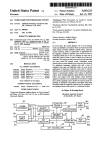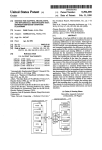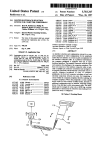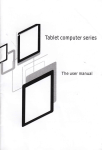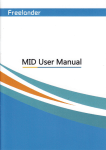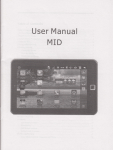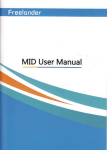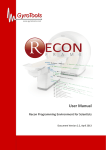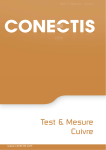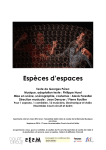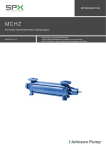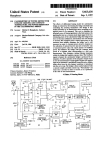Download Method for mapping, translating, and dynamically reconciling data
Transcript
USOO5666553A Ulllted States Patent [19] [11] Patent Number: 5,666,553 Crozier [45] Date of Patent: Sep. 9, 1997 [54] METHOD FOR MAPPING, TRANSLATING, OTHER PUBLICATIONS AND DYNAMICALLY RECONCILING DATA _ _ BETWEEN DISPARATE COMPUTER Al?en, ‘The Best of WordPerfect Version 5.0.” Hayden PLATFORMS Books, pp. 153-165, 429-435 (1988).“Automatically Syn chronized Objects,” Research Disclosure #29261, p. 614 [75] Inventor: Keith Crozier, Acton, Mass. (Aug- 1938) Cobb et al., “Paradox 3.5 Handbook 3rd Edition.” Bantam, pp. 803-816 (1991). I [73] Assignee: Puma Technology, Inc., San Jose. Calif. (List continued on next page.) [21] App1‘ NO‘: 279’201 [22] Filed; Jul_ 22, 1994 Primary Examiner-—Heather R. Herndon Assistant Examiner—Joseph R. Burwell . Attorney, Agent, or Firm-Fish & Richardson RC. Related US. Application Data [63] [57] Continuation of Ser. No. 867,167, Apr. 10, 1992, Pat. No. ABSTRACT Traditionally’ it has bean difficult to Share data among 51392390" diverse computer applications and platforms because of [51] 1111. C16 ........................... .. G06F 17/00; G06F 17/30 underlying differences in data formats- Although the mean [52] 395,803; 395,619 ing or 1puipose of the data may bee‘ similar or identical (for [58] Field of Search ................................... .. 395/161, 144, applications), the dl-?crences in data formats required by the 395,153’ 200’ 600’ 803’ 347’ 619 various computer applications and platforms renders such examp e, two appointments enter - [56] sharing dif?cult. Amethod is disclosed for the translation of Refelences Cited dissimilarly-formatted data between disparate computer applications and platforms. The method also provides for the 115- PATENT DOCUMENTS 4 432 057 2/1984 Daniell et a1 4,807,132 2/1989 Queen ........... .. 4,866,611 4,875,159 using separate computer dynamic reconciliation of con?icts in the data (for example, .................... .. 395/608 two appointments schgduled at the Same time) based on both the content of the data and on speci?c preferences indicated by the user of the translation facility. First, the data is 9/1989 Cree et a1. .... .. 10/1989 Cary et al. ........ .. translated to a common format based on the user-speci?ed 9/1990 George et a1. .. mapping of data ?elds (identifying handheld and desktop 5,065,360 11/1991 my _____________ __ ?elds to be translated) and considering the characteristics of 5,142,619 g/1992 websm, 111 the handheld or desktop computer application. Then, if the 5,137,737 5,210,868 211993 SM et a1_ ______ __ 5/1993 Shimada et a1. speci?c data item (such as an appointment, telephone book entry, or memo entry) already exists on the desktop com 5,237,678 8/1993 Keuchler et a1. 4,956,809 puter application or platform, the user is optionally noti?ed 5,251,291 10/1993 Malcolm ....... .. . of the con?ict and given the opportunity to replace the 5,261,045 11/1993 Scully et a1. existing data, ignore the incoming data. or modify the 5,261,094 11/1993 EWISOII et a1- 5,272,623 12/ 1993 incoming data. The criten'a for determining the existence of con?icts is disclosed for updating schedule infonnation and keyed databases. 5,278,978 1/1994 5,283,887 5,301,313 2/1994 4/1994 5,315,709 5,327,555 5/1994 7/1994 9 Claims, 8 Micro?che Appendix Included (1 Micro?che, 330 Pages) (List continued on next page.) DESKTOP COMPUTER /115 HANDHELD COMPUTEH /1 01 F121 103 PERSONAL INFORMATION MANAGER PHONE 10s F123 SCHEDULE 107 ' TQ‘DO “7 129 DATA F BASE H H D T DT MAP MANAGER C C or ' 119 a‘i'oM x11 109 DATA M 125 5 or SPHEADSHEET MRECON+JF> MANAGER 13‘; I 127 Km WORD PROCESSING MEMO ShCBtS MANAGER 5,666,553 Page 2 US. PATENT DOCUIVIENTS 5,333,252 5,339,392 8/1994 Risberg et a1. 5,339,434 8/1994 Rusis ............ .. 5,392,390 2/1995 Crozier . . . . . . . . . . . 5,434,994 7/1995 Shaheen et a1. 5,475,833 12/1995 Dauerer et a1. 5,519,606 User Manual for PC-Link for the B.O.S.S. and the PC-Link 7/1994 Brwer, III et a1. ................... .. 395/148 395/161 395120018 . . . .. 395/335 395/617 395/617 5/1996 Frid-VVrelsen et a1. ............... .. 395/209 for the B.O.S.S., Traveling Software, Inc. (1989). Zahn et aL, Network Computing Architecture, pp. 1-11; 19-31; 87-115; 117-133; 187-199; 201-209 (1990). “FRX extends reporting power of Platinum Series: (IBM Desktop Software’s line of accounting software)”, Doug Dayton, PC Week, v. 8, No. 5, p. 29(2), Feb. 4, 1991. OTHER PUBLICATIONS ‘The Big Picture (Accessing information on remote data IntelliLink Brochure (1990). “Open Network Computing—Technical Overview,” Sun Technical Report, Microsystems, Inc., pp. 1-32 (1987). Organizer Link II Operation Manual, Sharp Electronics Corporation (no date). management system)”, UNIX Review, v01. 7, No. 8, p. 38(7), Aug. 1989. ~ “Logical Connectivity: Application, Requirements, Archi tecture, and Research Agenda,” Stuart Madnick & Y. Rich User Manual for Connectivity Pack for the HP 95LX, ard Wang, MIT, System Sciences, 1991, Hawaii Int’l Conf., Hewlett Packard Company (1991). vol. 1, IEEE, Jun. 1991. US. Patent Sep. 9, 1997 Sheet 1 of 3 5,666,553 DESKTOP COMPUTER /115 HANDHELD COMPUTER (101 ["121 (I03 PERSONAL PHONE P> INFORMATION MANAGER ‘- r105 F123 SCHEDULE +— r107 ‘ TO-DO [H7 129 F H D H T C C DT MANAGER DT ‘~“1'19 DATA M ‘1 F125 M - r109 BASE MAP ‘‘ <——>O@1O XLT <1 M DATA —> DT ._ MREC‘ON‘» ‘31 SPREADSHEET MANAGER J f‘127 r111 WORD ——> PROCESSING MEMO ‘_ FIG 1 MANAGER, US. Patent Sep. 9, 1997 Sheet 2 of 8 HANDHELD COMPUTER (101 PHONE ' f 5,666,553 DESKTOP (“5 COMPUTER 10s 201v NAME 203v NUMBER 4* 20s» ADDRESS LINE I 207» ADDRESS LINE 2 209v ADDRESS LlNE N SCHEDULE 105 211v DATE 213» START TIME ‘ EEEHEME 4-“ COMMUNICATIONS 219» DESCRIPTION &TRANSLATION —> HHCOMM ‘@qI DTCOMM TO-DO 1,07 - 221v PRIORITY 223v DUE DATE 4- 225» DESCRIPTION I13/ \117 COMMON FORMAT r200 DATA 109 / 22?» FIELD 1 231 N " MEMO 233» DESCRIPTION 235» TEXT DATA RECORDI 237 DATA RECORD 2 V239 DATA RECORD 3 \/241 DATA RECORD N III / ‘_ FIG 2 43 U.S. Patent Sep. 9, 1997 Sheet 3 of 8 5,666,553 DESKTOP COMPUTER @115 PERSONAL INFORMATION MANAGER COMMON FORMAT 200 PHONE DATA RECORDI 361 DATA RECORO2 “363 DATA RECORD3 A65 ‘———> '3“ w DATA RECORDN “367 —> _ 119'] (371 (121 APPOINTMENT r373 NAME V801 BUSINESS PHONE \/803 HOME PHONE V805 DATE START TIME END TIME M321 V323 “325 FAX NUMBER \/307 ALARM “327 TITLE V309 DESCRIPTION ‘r329 COMPANY ~61 I 70-00 STREET CITY, STATE ZIP \/313 Ems v31? DESCRIPTION \/331 PRIORITY \rsss DUE DATE \f335 NOTES V319 DETAIL r375 \’ 337 TRANSLATION DTxLT 4+6 DATABASE 129’) MAPPING MANAGER r123 ‘ < f'\ - DTMAP 131") RECONCILIATION DTRECON USER DATAI \r339 USER DATA 2 “341 ___f\__—___> USER DATA 4 N “343 SPREADSHEETF125 USER DATA I USER DATA 2 PJ USER DATA N M345 \/347 9*; “349 WOFID PROCESSOR (127 DESCRIPTION %, TEXT FIG 3 V351 \r353 US. Patent Sep. 9, 1997 Sheet 4 of 8 HANDHELD COMPUTER (\101 DATA DESKTOP COMPUTER 109 FIELD 1 FIELD 3 LINE 1 E2 FIELD s 4 5,666,553 (‘115 DATABASE MANAGER r123 1 03 5 7 9 11 CUSTOMER NAME CUSTOMER NUMBER ORDER DATE OUANITY ITEM PRICE <_—> FIG 4 SCHEDULE MAP TABLE @_ DATE 12121991 12151991 12161991 12161991 12171991 START 1000 1100 0800 1000 1400 END ALARM DESCRIPTION 1100 0945 MEETING-HELEN 1300 0 LUNCH-JIM 1 100 0745 MEETING-TOM 1100 0 PRESENTATION 1600 1345 DENTIST 12181991 0800 0900 O INTERVIEW MIKE 12211991 12251991 1300 900 1400 1700 0 0 LUNCH CHRISTMAS FIG 6 v41?) \/415 \/417 ~r41 9 \/421 V423 US. Patent Sep. 9, 1997 I Sheet 5 0f 8 5,666,553 Field Mapping TEL PARADOX PARADOX HandHeld Fields: NAME Field Mapping: Field Mapping: CUSTNAME NUMBER - QK cusmo ADDRESS_LINE 1 EM ADDRESS LINE 2 Q RD D ATE ADDHESS_LINE 3 ADDRESS_I_INE 4 ADDRESS_LINE s ADDRESS_LINE 6 ADDRESS__LINE 7 ADDRESS_LINE 8 PRICE QTY Remove . Add F'e'd New Field Name: FIG 5A L Field Mapping TEL PARADOX PARADOX HandHeld Fields: NAME Field Mapping: Field Mapping: CUSTNAME NUMBER ADDRESSLLINE 1 ADDRESS LINE 2 ADDRESS__L|NE 3 ADDFIESS_LINE 4 ADDRESS_LINE 5 ADDRESS_LINE 6 ADDRESS_LINE 7 ADDRESS_LINE 8 CUSTNO ITEM QTY ORDDATE PRICE QTY FIG 5B I QK Bemove . Add He'd New Field Name: US. Patent Sep. 9, 1997 T Sheet 6 of s ‘ 5,666,553 Field Update 1 Key Field Name: Name John Jones [Handheld Data NUMBER__Line1 212-111-3333 _PC Data Business Phone (212)111-2222 t L T @ Schedule Update FHandhetd Data Announcement Date: Start Time: End Time: [32/26/92 1 [09:30AM @BOAW PC Data Meeting with Jim Date: 02/26/92 Start Time: 09 :OOAM L FIG 8 T End Time: 1O :OOAM @ US. Patent Sep. 9, 1997 5,666,553 Sheet 7 of 8 MAPPING Database Fields Data Name Description ‘ Format HH Type HH Application DT Application DT File Name HH File Name Record Number HH Field Name A06 A15 A25 A64 A64 N Handheld make/model Handheld Application Name Desktop Application Name Name 01 Desktop database file Name of Handheld database file Unique record id A15 DT Field Name A25 Multiple Field ?ag T/F Name of the Handheld field and subtield number Field Name within "DT File Name" Indicator that HH logical field has multiple physical fields Number of HH Fields N Field Type Number of Keys Number of real Handheld Fields A04 N Field type of Desktop Field Number of fields in Desktop database key ' Data format codes: A nn A string of length nn An integer A boolean true/false value FIG 9 MAPPlNG Database for FIG. 4 HHType HHApp DTApp Psion Psion Psion Psion Psion Psion DATA DATA DATA DATA DATA DATA Paradox Paradox Paradox Paradox Paradox Paradox Recno HHFldNam DTFldNam FlELDl FlELDZ FlELDSLl FIELD3L2 FlELD3L3 FIELD3L4 FIG 10 CUSTNAME CUSTNO ITEM QTY PRICE ORDDATE' MullFld N N Y Y Y Y US. Patent Sep. 9, 1997 5,666,553 Sheet 8 0f 8 RECONCILLIATION OF HANDHELD DATA and DESKTOP DATABASE MANAGER TRANSLATION Hancthetd Computer Data Rec# 1 . (IT-BON FlELDt Ajax FIELD2 F1ELD3L1 FIELD3L2 FIELD3L3 FIELD3L4 201 Fan 10 $100 2/3/92 Brown Dillard Sheraton Avis 306 443 617 023 Heater Toaster Phone 2 5 100 $125 $75 $5000 2/9/92 2/12/92 2/27/92 Ashtray 20 $100 2/15/92 Desktop Computer Data Ret:# CUSTNAME CUSTNO ORDDATE QTY 1 Ajax 201 2/3/92 10 Brown 306 3/2/92 Dillard 443 2/12/92 Sheraton 617 2/27/92 Avis 023 3/10/92 mawro FIG 11 ITEM Fan Heater Toaster Phone Ashtray PRICE $100 $250 $75 $5000 $400 ' 5,666,553 1 2 METHOD FOR MAPPING, TRANSLATING, described by the ?elds’ names, data formats, and byte offsets AND DYNAMICALLY RECONCILING DATA BETWEEN DISPARATE COMPUTER PLATFORMS in the record. The ?le format’s rules include a description of the record structure of the constituent data records, the record structure for any header records and how these header This is a continuation of application Ser. No. 07/867,167, ?led Apr. 10. 1992, now US. Pat No. 5,392,390. help ?nd a record, and any rules that application programs records aid navigation to ?nd speci?c data records and/or speci?c ?elds within those records, “hidden” key tags to use to access a particular record and ?eld. REFERENCE TO MICROFICHE APPENDIX A source code listing of the preferred embodiment of the invention is appended in the form of a ?che and 330 pages 10 general databases, that is, database ?les whose record struc A portion of the disclosure of this patent document contains material that is subject to copyright protection. The copyright owner has no objection to the facsimile reproduc tion by anyone of the patent document or the patent disclo sure as it appears in the Patent and Trademark Otlice ?le or records. but otherwise reserves all copyright rights whatso 20 BACKGROUND OF THE INVENTION This invention relates to programs that share data across 25 and spreadsheet functions. Owing to the physical and memory size, and processing power limitations of the hand held computers, however, these applications are generally designated as the key, the “name” by which the record can 30 0 limited in functionality and differ in data content and usage from similar applications on desktop computers. phone number. This record structure would have been encoded in a data structure declaration in the source of the program. One or more of the ?elds of a database record structure are some combination of personal information management functions, database functions, word processing functions, ers in the database ?le. These data dictionary records specify each ?eld’s name, start byte offset within the record, and data format. Examples of database manager programs include Paradox, dbase, and IBM Current. Other database ?les are managed by special-purpose application programs. These programs work on databases of one speci?ed record structure; this speci?cation is embedded in the code of the program rather than in header records of the ?le. For instance. a telephone directory program may work on ?les with a 32-character name and a 10-character disparate computer applications and platforms, such as handheld computers and desktop computers. Handheld computers typically weigh less than a pound and ?t in a pocket. Handheld computers typically provide grams. A database manager is a program for managing ture can be speci?ed at creation time by the user. Database manager programs maintain data dictionary records as head recorded on micro?che. ever. Database ?les are managed by two broad classes of programs, database managers and other application pro be speci?ed for reading or writing. Some database ?les, typically those for schedule application programs, have “range keys”—the key speci?es start and end points in a l-dimensional key space rather than a single point in the (possibly multi-dimensional) key space. Range keys may 35 Many users of handheld computers also own a desktop specify multiple intervals, for instance “9 AM to 10 AM every Monday until November 17.” Where non-range keys computer used for applications that manage data similar to the data carried in the handheld computer. In such cases, the user normally would want the same data on the desktop must be unique—there cannot be two records with the same computer as in the handheld computer. There are a number should brought to the attention of the user. Because handheld computers of the cm‘rent generation are diskless, “?les” in the classical sense do not exist on many of these handheld computers. Within this patent, the term ?le should be understood to include the memory-resident datasets of a handheld computer, and the serial bit stream format in which a handheld computer sends or receives data non-range key—range keys may overlap or even be exactly equal, though typically these are undesirable situations and of programs that transfer data between handheld computers and desktop computers, but they all create desktop comput er’s data with no regard for prior contents. As a result, all updates that have been done to the desktop computer’s data prior to the transfer are ignored. 45 Many desktop computer applications have their data to/from another computer. File copying and data conversion are long-standing prob lems in the art, and many solutions to ditferent parts of the problem have been offered US. Pat. N0. 4,966,809 describes a technique for sharing stored in large, complex, proprietary formats. Data transfer to these applications usually cannot take place through ?le transfer, because the data comes from the handheld com puter in a different format and usually is a subset of the data held on the deslnop computer. In such cases, data can only be communicated to and from the desktop application by the data among disparate platfonns with differing data formats, use of a database manager or by use of dynamic inter but leaves unsolved the problems of sharing data among platforms that require different record structures or ?le formats (broader problems that include the data format application communication techniques. Many handheld and desktop programs work with database ?les. Database ?les have a ?le format, the set of rules by 55 problem as a constituent), and does not provide a method for a user of these disparate platforms to conveniently instruct his system about his environment so that the system will which data can be read from or written to the ?le. A database ?le is composed of records, some of which are data records with the data of interest to the application program and the user, and often some header records. Each data record is composed of ?elds, and each ?eld has a name and a data apply itself in that environment. There are several ?le transfer programs for communicat ing between computers, including Organizer Link 2 from Sharp® Electronics, PC-Link for the Casio B.O.S.S.TM from Traveling Software®, HP95LX Connectivity Pack from format. Examples of data formats include 1-, 2-, and 4-byte integers, a 4-byte or 8-byte ?oating point number, or one or more ASCII text strings. In the case of multiple text strings in one ?eld, the strings (or sub?elds) are separated by a 65 Hewlett Packard, and 3 Link from Psion PLC. These ?le transfer programs do not provide the invention’s user special character such as tab or linefeed. Each data record of speci?able ?eld mapping of data nor dynamic reconciliation a ?le shares the same record structure: a record structure is of data. 5,666,553 3 4 SUMIVIARY OF THE INVENTION ?elds of the two record structures by presenting the names of the ?elds of each of the record structures on a display, and The current invention solves the problem of sharing data allowing a user to specify the correspondence between pairs between disparate application programs by providing user speci?able ?eld mapping of data and dynamic reconciliation of ?elds. The actual translation of ?les then makes use of this mapping to translate the data of a ?le from the source record structure to the destination record structure. of con?icts. In preferred embodiments. the invention features accept ing data from a ?rst computer application, and then mapping and translating the data to the formats expected by a second computer application. The user of the translation facility may explicitly specify the mapping of the data ?elds of the two applications’ ?les. Dining the data transfer, the user may also choose to be informed of application-speci?c con?icts between data received from the ?rst application and that already existing on the second platform. When a data Other features and advantages of the invention will be apparent from the following description of preferred embodiments, and from the claims. 10 BRIEF DESCRIPTION OF THE DRAWINGS FIG. 1 is a block diagram of a preferred embodiment of the invention. FIG. 2 shows examples of the transfer and translation of data from handheld applications and computers to common con?ict is encountered, the user may then opt to accept, ignore, or change the data before it is applied to the second record structures. application’s ?les. even if the disparity is relatively minor, as for instance FIG. 3 shows examples of the transfer and translation of data from the common record structures to desktop appli cations and computers. FIG. 4 shows an example of the detailed mapping of ?elds between a Paradox database manager and a dBase database manager running on the same IBM PC. between a handheld and desktop applications. The invention can also be used to transfer, compare and reconcile data between any other pair of disparate platforms, The invention provides an effective method of translating data between disparate computer platforms and a wide variety of applications, while ensuring that the data need only be entered once (and not duplicated). 20 (specifying correspondence between handheld and desktop) 25 and platforms. The invention also ensures the integrity of the data imported to computer applications, through the process of con?ict resolution (also known as data reconciliation). 30 In a ?rst aspect, the invention features a method for an interactive user of a computer to dynamically reconcile the information of two database ?les. The method comprises the steps of choosing corresponding records from the two ?les, comparing the information of corresponding ?elds of these FIGS. 5A and 5B show a sample screen display which enables the user to specify the mapping or correspondence of ?eld names between handheld and desldop applications 35 records, and allowing the user to decide how to change the data in one of the two ?les to bring them into agreement In preferred embodiments in which the records of the two ?les are named by range keys, as in an appointment schedule application, the method comprises determining if any sched ule con?icts exist (either the time of an appointment has been changed in one of the two schedule databases, or there are two di?erent appointments for con?icting times) and allowing the user to decide how to change the data in one of 45 the two ?les to bring them into agreement The invention o?’ers a solution to previously unsolved portions of the data translation problem, by providing means FIG. 6 shows an application-speci?c reconciliation table used internally by the translation software to achieve data reconciliation. FIG. 7 shows a sample screen display which noti?es the user of con?icts between handheld and desktop data for reconciliation purposes. FIG. 8 shows a sample screen display which noti?es the user of con?icts between schedule data contained on the handheld and desktop applications and platforms. FIG. 9 shows the ?eld structure of the ?eld mapping database. FIG. 10 shows a sample ?eld mapping database. FIG. 11 shows an example of data translated between a handheld computer database and a desktop computer data base. DESCRIPTION OF THE PREFERRED EMBODIMENT(S) The preferred embodiment comprises several large pro grams with a number of steps that run on the desktop to translate data from one record structure to another. In a second aspect, the invention features a method for 50 computer, and a small ?le transfer program that runs as a slave on programmable handheld computers. The major translating computer data from a source record structure to steps of the main program are: a destination record structure. The invention offers transla tions that are new in the art, by translating between source and destination record structures that diifer in ?eld naming, ?eld order, or one-to-many or many-to-one ?eld correspon 55 dence. The method comprises the steps of establishing a mapping between the ?elds of the two record structures, and using that mapping to translate the data of a source ?le into the destination record structm'e. The invention provides both a framework and a conve nient user interface for tying together previous data trans lation techniques into a more broadly-applicable and easy to-use system. In a third aspect, the invention features a method for translating computer data from a source record structure to 65 a different destination record structure. The method com prises the steps of ?rst establishing a mapping between the 1. Mapping of ?elds from desktop data formats to hand held data formats if required 2. Transfer of data from handheld to desktop 3. Translation of data to deslqop format 4. Dynamic reconciliation of con?icts The mapping step establishes correspondences between ?elds of pairs of ?les. On import, the transfer step brings the handheld data into the desktop computer. The translation step uses the rules provided by the mapping step to convert the handheld data in one format to desldop data in another format. The dynamic reconciliation step informs the user of con?icts in the data and allows him to make decisions about whether to accept the new data, ignore it, or change it. A menu driver is provided to select which handheld applica tions to translate to which desktop applications. 5 ,666,553 5 6 The preferred embodiment also provides the capability to application communication facility. An inter-application communication facility is provided by some application export and translate data from the desktop computer to the handheld computer. In this case, the steps are: programs so that other programs may read and write data 1. Mapping of ?elds from desktop data formats to hand held data formats if required 2. Transfer of data from desktop to handheld ?les maintained by the application. In addition to the normal program start entry point. the application program’s image has other entry points that provide services like ‘Tell me the 3. Translation of data to handheld format Again, the above steps are under the control of a menu driver. The following detailed description focuses on the names of all ?elds in your records,” “Give me the data format for the ?eld whose name is BUSINESS PHONE”, ” “Give me the next record key”. “Give me the information of mapping. transfer, and translation between the handheld computer and the desktop computer as well as the dynamic reconciliation of the data during translation. The mapping, transfer, and translation of the data from the desktop com puter and the handheld computer is essentially identical except that there is no reconciliation, because the desktop data replaces the handheld data in the preferred embodiment owing to built-in constraints in most handheld computers. Windows Dynamic Data Exchange (DDE) is an example of this type of inter-application communication facility which is used by the preferred embodiment with desktop computer the CITY ?eld for the record whose key is ‘John Jones’.” applications such as IBM Current and Polaris PackRaI. When neither of these two methods are available to the mapping facility for acquiring an understanding of the record structure, then in a third method, a description of the record structure (or the handheld’s byte-stream format) is FIG. 1 shows a HANDHELD COMPUTER 101 with brute force hard-coded in a way that makes the information available to the mapping and translation facilities. In some applications PHONE 103, SCHEDULE 105, TODO 107, DATA 109, and MEMO 111 transferring data to a desktop cases, the developer of the application publishes the ?le computer using ?le transfer application HHCOMM 113. HHCOMM 113 is responsible for accepting the data from the handheld computer and translating it to the COMMON RECORD STRUCTURES, which are de?ned by the pre ferred embodiment. The COMMON RECORD STRUC TUREs are then passed to DESKTOP COMPUTER 115 by transfer application UTCOMM 117 which utilizes DTXLT format. For instance, for the HP95LX handheld computer SCHEDULE application, the byte stream representation of the ?le’s record structure is: 25 119 inter-application communications or database manager facilities as appropriate to translate the data to formats accepted by desktop applications PERSONAL INFORMA 30 TION MANAGER 121, DATABASE MANAGER 123, SPREADSHEEI‘ PROGRAM 125, or WORD PROCESS ING PROGRAM 127. Before communicating with the desktop application, the user may specify the mapping of handheld and desktop 35 application data for the PHONE 103 and DATA 109 appli Date Start Time End Time 3 l-byte integers 2-byte integer 2-byte integer Alarm Description l-byte integer 27-byte ASCII string Note 4E-byte ASCH string The preferred embodiment provides hard-coded record descriptors for the PHONE 103, SCHEDULE 105, TODO 107, DATA 109, and MEMO 111 applications provided by each of the supported handheld computers. In some cases the ?eld names are obtained from the actual ?eld names in the cations by utilizing the mapping facilities of DTMAP 129. A default mapping is provided for the other applications. handheld computer’s implementation and used as the ?eld names for the target application. An example of this would be the DATA application in the programmable Psion Series 3 handheld computer. In a fourth method contemplated by the inventor but not implemented in the current embodiment, a data dictionary of The user may optionally request from DTRECON 131 that con?icts between the handheld and desktop data be reconciled dynamically, thereby giving the user the option of accepting, ignoring, or changing any con?icting data. The mapping step of the program builds a set of mles that the translate step will use to translate data from one record the record structure can be coded into a text ?le, and the structure to another. The mapping step must be run once for 45 mapping step can read and interpret this text ?le much as it each pair of source-destination ?le formats where one of the ?les is a keyed database, such as PHONE 103 or DATA 109. The output of a mapping step is a mapping database that can be used for any number of translate steps in the future. There are two steps to the mapping process: (1) Acquiring reads and interprets a database’s data dictionary. Once the mapping facility has acquired an understanding of the ?elds of each of the two record structures, the next step is to establish the actual ?eld mappings-—for instance, 50 the ?eld names and data format of each ?eld of each of the to establish a correspondence between a PHONE 103 ?eld of ?le format 1 and a FAX NUMBER 307 ?eld of ?le format two record structures; and (2) establishing a correspondence 2, and to determine the data conversion rule for mapping a between the ?elds of the source structure and the destination datum of ?eld PHONE to a datum of ?eld FAX NUMBER structure. Once a mapping between two record structures is 307, for instance “convert 3 2-byte integers to 10 ASClI established. it is maintained in a ?eld mapping database for 55 characters.” This is accomplished by a user, who is pre use by the translation steps. sented with a list of all the ?elds of each of the two record There are three methods by which ?eld names and data structures, and then asked to select corresponding names. formats can be acquired, each method described in more It is sometimes preferable to not provide a mapping detail in following paragraphs. Some ?les, notably including ?les managed by database destination application’s ?le format, but to provide map manager programs, have data dictionary records as headers pings from the source format to a COMMON RECORD in the database ?le. These data dictionary records provide STRUCTURE 200, and a mapping from the COMMON RECORD STRUCTURE 200 to the destination format This directly from the source application’s ?le format to the exactly the information required. For example, the Paradox Engine data access facility provides all ?eld names for a Paradox database upon request in the preferred embodiment In a second method, the application program provides this information to the mapping facility through an inter case is most typical when one or both of the ?le formats are 65 in the third brute-force category. The COMMON RECORD STRUCTURE 200 is typically chosen from one of the application programs’ record structures. For instance. in the 5,666,553 7 8 case of handheld computer PHONE 103 ?les, the program translates all PHONE 103 databases into the format used by MAPPINGs database are bi-directional (i.e., the mappings are applicable both for handheld computer to desktop the Sharp Wizard® handheld computer. The COMMON RECORD STRUCTURES 300 are de?ned by the preferred embodiment for applications PHONE 103, SCHEDULE 105, TOD0 107, DATA 109, and MEMO 111. These formats generally are determined by the hardware characteristics of the handheld computer. They are hard-coded into the pre ferred embodiment for each handheld computer. PHONE computer, and desldop computer to handheld computer), the appearance of multiple records in the MAPPING database with the “multiple ?eld ?ag” can cause multiple ?elds from 103 and DATA 109 are similar and provide for a single a source database to be combined in a single ?eld in a target database. For instance, the example of FIG. 5 shows a case Where one ?eld in the handheld application (ADDRESS) can be mapped to eight ?elds in the desktop application by 10 specifying mapping for ADDRESS_LINEI through keyed indexed database with multiple sub?elds allowed in non-indexed ?elds. Examples of the COMMON RECORD ADDRESS_LINE8. STRUCTURES 300 are shown in FIG. 2 for applications Type” speci?es the handheld make/model, such as the Sharp PHONE 103, SCHEDULE 105,TODO 107, DATA 109, and Wizard, HP95LX Palmtop Computer, the Casio B.O.S.S., MEMO 111. FIG. 3 shows an example of translation of data between the COMMON RECORD STRUCTURE 200, containing and the Psion Series 3. “HH Application” speci?es the handheld application name, such as PHONE, SCHEDULE, or MEMO. “DT Application” speci?es the desktop applica DATA RECORDI 361, DATA RECORD2 363,. . . DATA tion name, such as PackRat, or dBASE. “DT File Name” FIG. 9 shows the ?elds for the MAPPING database. “HH RECORDn 367 to various desktop applications such as a PERSONAL INFORMATION MANAGER 121 containing PERSON 371 data ?elds (NAME 301, BUSINESS PHONE 303, HOME PHONE 305, FAX NUMBER 307, TITLE 309, COMPANY 311, STREET 313, CITY, STATE 315, ZIP317, and NOTES 319). APPOINTMENT 373 data ?elds (DATE 321, START TIME 323, END TIME 325, ALARM 327, and DESCRIPTION 329), and TODO 375 data ?elds (DESCRIPTION 331, PRIORITY 333, DUE DATE 335, and DETAIL 337). FIG. 3 also shows the DTMAP 129 function which provides ?eld mapping for a DATABASE MANAGER 123. The user of the preferred embodiment is allowed to specify the destination ?eld that corresponds to each ?eld in the handheld application database. As the translation takes place, the ?elds are mapped according to the user speci? cation into the desktop application database. 20 25 30 35 FIG. 4 shows an example of ?eld mapping between an application’s data 109 (FIELDI 401, FIELD2 403, FIELD3 405, FIELD4 407, FIELDS 409) of a HANDHELD COM PU'IER 101, and a database manager application’s data (CUSTOMER NAME 413, CUSTOMER NUMBER 415, ORDER DATE 417, QUANTITY 419, I'IEM 421, and PRICE 423) of a DESKTOP COMPUTER 115. FIG. 5 shows an example of the preferred embodiment’s screen display which allows the user to specify ?eld map ping. In this example, the translation is between a handheld computer’s TEL database and the PARADOX database. In FIG. 5a, the user has selected a handheld ?eld from the TEL column, such as ADDRESS_LINE2, and a desktop ?eld 40 speci?es the name of the desktop database ?le, such as C:\SK2\ADDRESS.DB for the Sidekick 2.0 PHONE/ ADDRESS application. “HH File Name” speci?es the name of handheld database ?le such as C:\_DAT_IL.PBK for the name of the ?le to be used by the PHONE application on the HP95LX. “Record Number” speci?es the unique record id of the record in the MAPPING database which is required by the preferred embodiment for record uniqueness from a processing standpoint. “HH Field Name” speci?es the name of the handheld ?eld and sub?eld number for each mapping record, such as ADDRESS_LINE3. “UT Field Name” speci?es the ?eld name within “DT File Name”, such as BUSINESS PHONE. “Multiple Field ?ag” is an indicator that “HH Field Name” is a member of a group of multiple ?elds to be mapped to/from a single physical ?eld. “Number of HH Fields” speci?es the number of real handheld ?elds in the handheld computer, which is information needed by the preferred embodiment (manually provided in the pre ferred embodiment). “Field Type” speci?es the ?eld type of “DT Field Name”, such as A025 for ASCII, 25 bytes. “Number of Keys”, speci?es the number of ?elds in the desktop database manager’s database. The MAPPING database is created using an o?'lthe-shelf database manager; in the preferred embodiment it is Paradox or C-Tree. At MAPPING database creation time, the above ?elds are de?ned. Each handheld application is introduced to the MAPPING database by manually entering the “HH Type”, “HH Application”, DT Application”, “Record Number”, “HH Field Name”, ‘Multiple Field ?ag”, “Num ber of HH Fields”, and “Number of Fields” ?elds “DT File from the PARADOX column, in this case QTY. The selec Name” and HH File Name” are created dynamically dining tion is made by clicking a mouse (or trackball, or other 50 mapping by the preferred embodiment. For some desktop pointer device) on the two respective ?eld names. In FIG. applications, such as Polaris PackRat, the “DT Field Name” 5b, the mapping between these two ?elds is completed, and “Field Type” are manually entered into the MAPPING denoted by the ?eld name from the desktop database dis database. For some other desktop applications such as played in the middle mapping column next to the ?eld name Paradox, the Paradox Engine can be used to query a Paradox from the handheld database. The mapping is stored in a 55 database to provide the “DT Field Name” and “Field Type”. MAPPING database, which is referenced during the trans Pseudocode for the speci?cation of ?eld mapping of data lation operation. between the handheld computers and the desktop computer The MAPPING database will be used during the transla tion process to determine where data from each ?eld of the source application record is to be stored in the target application record. Each record of the MAPPING database is shown in TABLE 1. The code implementing this is on pages 60-65 of the micro?che appendix. TABLE 1 describes all or part of the mapping of a single ?eld of a handheld application’s data ?le. In the case where a single ?eld in the source database is to be mapped to multiple ?elds in the target database, multiple records will appear in the MAPPING database for that target ?eld, with the “multiple ?eld ?ag” set to TRUE. Because the mappings in the Pseudocode for Speci?cation of Field Mapping of Data between Handheld and Desktop Applications 101 102 Open MAPPING database Display handheld ?eld names 5,666,553 9 10 (NAME 201, NUMBER 203, ADDRESS 205, etc.), SCHEDULE 105 data ?elds (DATE 211, START TIME 213, END TIME 215, ALARM 217. and DESCRIPTION 219), TODO 107 data ?elds (PRIORITY 221, DUE DATE 223, and DESCRIPTION 225). DATA 109 data ?elds (FIELDI TABLE I-continued Pseudocode for Speci?cation of Field Mapping of Data between Handheld and Desktop Applications 103 104 IF mapping previously speci?ed Display previots desktop ?eld mappings 105 106 D0 UNTIL user presses OK button IF met speci?es a handheld ?eld to re-map 107 227, FIELD2 229, . . . FIELDn 231). and MEMO 111 data ?elds (DESCRIPTION 233 and TEXT 235) to desktop computer application DTCOMM 117 , which reads and translates the handheld computer data to the COMMON Display desktop ?elds which are eligible for mapping 10 RECORD STRUCTURE 200 containing DATA RECORDI 108 Ask user for desktop ?eld to map 237. DATA RECORD2 239, . . . DATA RECORDn 243. 109 Update cksktop ?eld table for speci?ed Once the mapping has been speci?ed and the data transferred. the translation may take place. The translation process for PHONE 103 and DATA 109 handheld data to database manager databases is controlled by the MAPPING handheld ?eld 110 Display new desktop ?eld mappin lll END IF 112 113 IF user speci?es Cancel Exit 114 115 ' database. Each record represents a ?eld or sub?eld of the handheld computer’s data. The mapping is performed to ?elds in the desktop application’s database based on the ?eld names of the desktop’s application. END D0 UNTm user presses OK button Write new MAPPING databae The preferred embodiment allows the use of one-to-many ?eld mappings and many-to-one ?eld mappings. One-to The MAPPING database for the data in FIG. 4 would 20 contain records as shown in FIG. 10. In this case, FIELDI 25 data from the handheld would be mapped to the CUST NAME ?eld of the desktop application, FIELD2 data from the handheld would be mapped to CUSTNO, FIELD3LI data would be mapped to ITEM. FIELD3L2 data would be mapped to QTY, FIELD3L3 data would be mapped to PRICE, and FIELD3L4 data would be mapped to ORD DATE. In this mapping, FIELDS of the handheld computer is a multiple-?eld mapping. FJELD3 has four sub?elds which are mapped to four ?elds in the desktop computer many means that a single text ?eld in the handheld appli cation’s data ?le can contain several pieces of data, delim ited by special characters, which will be translated to multiple ?elds in the desktop applications data ?le. Many to-one means that the reverse translation will take place. The one-to-many and many-to-one relationships are accomplished in the preferred embodiment by specifying multiple mapping records in the MAPPING database for a single ?eld in either the handheld computer or the desktop application. These records are marked specially as multiple ?eld-mappings for the translation process. Multiple-string ?elds are noted in the hard-coded description of the record structure (method 3). Future implementations will allow the database. user to specify that a ?eld has multiple sub?elds on a point-and-click menu. In the preferred embodiment, the user is presented with a screen as shown in FIG. 5 which displays the selections available for mapping. If the user wishes to establish map pings from the handheld ADDRESS 205—209 ?eld in the PHONE 103 application to a desktop Paradox database with ?elds such as TITLE 309, COMPANY 311, STREET 313, 35 TABLE 2 Pseudocode for Translating PHONE 103 or DATA 109 ?les 101 102 103 CITY, STATE 315, and ZIP 317, he is presented with sub?elds ADDRESS_Linel 205, ADDRESS_Line2 207, . . ., ADDRESS_LineN 209 ?elds for mapping. He then selects the sub?eld of ADDRESS_Linel 205 by clicking on the ADDRESS_LineI 205 and selects the desktop target ?eld TITLE 309. He then selects the sub?eld of ADDRESS_Line2 207 by clicking on the ADDRESS_ Line2 207 and selects the desktop target ?eld COMPANY 311. The process is repeated for each handheld sub?eld and Pseudocode for typical application-speci?c translation of keyed PHONE 103 or DATA 109 ?les between handheld applications and desktop applications is shown in TABLE 2. The code implementing this in the preferred embodiment is on pages 65-66, 102-106, 179-187, 203-206, and 237-246 of the micro?che appendix. 45 105 106 50 109 110 55 Build output ?eld or multiple ?elds when there are multiple mapping records per ?eld (one-to-many) The above process results in six records in the MAPPING database; the ?rst maps ADDRESS_Linel 205 to TITLE END DO FOR each input ?eld Write output record ENDDO UNI'Il_.al1inputd-atarecordshavebeenread In Step 102 of TABLE 2, the mapping structure is an internal data structure presenting the information needed for translation from the MAPPING database, containing the name, format, mapping, and multiple-?eld-mapping charac teristics of each ?eld. The process of building these data structures is accomplished by reading the MAPPING data base and storing its data in the structure for reference during the translation. The structure is an internal image of the MAPPING database built to facilitate processing in the facilities described is to copy data from a desktop computer FIG. 2 shows a handheld computer application HHCOMM 113 transferring PHONE 103 data ?elds Perform translations such as conversion handheld computer) 107 108 to a handheld, or vice-versa. Read handheld input record DO FOR each handheld input ?eld from handheld computer binary format to 12 hour ASCH AM/PM format (speci?c to each desktop target ?eld. 309, ADDRESS_Line2 207 to COMPANY 311, ADDRESS_Line3 to STREET 313, ADDRESS_Line4 to CITY 315, ADDRESS_LineS to STATE 315. and ADDRESS_Line6 to ZIP 317. Special coding in the pre ferred embodiment handles the CITY, STATE pairing. These records will be used by ?re translation process to map the six sub?elds in the ADDRESS ?eld of each record from the handheld computer to the six desktop ?elds in each target record in the desktop computer. The ?rst step in the use of the mapping and translation Read MAPPING database Build mapping structure for translation DO UNTIL last handheld input record has been read preferred embodiment. 65 \ Step 105 through 108 iterates through records in the mapping structure. Step 105 is performed for each ?eld of the handheld computer’s data. 5,666,553 11 12 Each handheld computer has its own format for its application data ?les. The data translations of step 106 are preferred embodiment’s screen display which allows the hard-coded into the translation facility of the preferred embodiment for each pair of source and destination data formats, as discussed earlier for the HP95LX handheld computer. An example is the conversion of the three single byte integer ?elds in the HP95LX date to an ASCII formatted date of mm/dd/yyyy. The year byte in the 1IP95LX format is number of years since 1900, so 1900 must be added to the single-byte integer (which has a maximum value of 255). In these data format conversions, the source bits differ ?'om the destination bits, but the information—the meaning of those bits in the context of the 10 record structure rules—is the same. Step 107 iterates through records in the mapping structure for ?elds in the handheld computer which have multiple ?eld-mapping characteristics. In this case, multiple mapping records will exist in the mapping structure (one for each 15 user to decide what to do about con?icts. In this case, the key ?eld is Name. If a record exists in the desktop application with the same Name, the data in each ?eld in the desktop is compared with the data from the handheld. If the data in any given ?eld is diiferent, the user may accept the update to the ?eld, ignore it, or edit part or all of the incoming data in the record and write it to the desktop application’ s ?le. Note that the ?nal result may be to update some ?elds of the desktop record and not others. An example of an application-speci?c technique is docu mented in TABLE 3 for the import of handheld computer DATA 109 to a deslozop computer DATABASE MANAGER 123 which contains an earlier version of the data in the handheld computer. The preferred embodiment’s code for this is on pages 110-111 and 246-248 of the micro?che appendix. TABLE 3 sub?eld). If a ?eld in the source ?le has been mapped to multiple ?elds in the destination, the splitting occurs by 20 recognizing tabs as sub?eld separators in the ?rst ?le. Conversely, if several ?elds in the source map to a single ?eld in the destination, the strings of the source ?elds are catenated together into the destination ?eld with tab sepa rators. The danger presented by the above-described transfer and translation facilities is the classic consistency problem. Once Pseudocode for Reconciliation of Data for DATA 109 Application (occurs for each record during Translation, Step 105-108 in TABLE 2) 101 25 102 103 IF there is a desktop record with the same key D0 UNTIL all ?elds in the handheld record are checked (based on mapping) BEGIN data has been copied to two separate computers, di?’erent— 104 105 and inevitably con?icting-updates may be applied to the two separate copies of the data. The user will often update the schedule he carries in his handheld computer, and the 106 user’s secretary may make changes to the desktop comput 107 er’s data while the user is away. Dynamic reconciliation allows the user of the handheld 108 computer to make changes to the handheld computer while away from the desldop computer and discover the effect of these changes when returning to the desktop computer. The dynamic reconciliation runs on the desldop computer during Query desktop application for existence of handheld record key in desktop database 35 the translation process from the handheld computer to the IF the handheld and desktop ?elds are unequal Ask user to pick the handheld ?eld, the desktop ?eld, or wishes to change the handheld data and use the changed data IF user wishes to change the handheld data Update handheld ?eld with changes ELSE IF user selects handheld data 109 Update desktop ?eld with handheld data 110 111 112 113 114 115 END IF END IF END DO ELSE create a desktop record from the handheld data END IF desktop computer and usually includes mapping of ?les of ditferent formats. FIG. 3 also shows the DTRECON 131 (Desktop inter-application communication facility to determine if Reconciliation) function which provides optional dynamic there is a record in the target application with the same key. Step 101 utilizes either a database manager query or an reconciliation of application-speci?c con?icts between Steps 102 and 103 may involve translating the informa incoming (handheld) data and existing (desktop) data, with 45 tion of both records into a common record structure dis capabilities to accept, ignore, or change incoming data. If a record from the handheld computer has a key which matches a record in the desktop computer, each handheld ?eld of the record is compared to each desktop ?eld. If they arev different, the user is queried for resolution. 50 FIG. 11 shows an example of data for a database man ager’s database in FIG. 4. In this case, when a translation takes place from the handheld computer database of user DAI‘A 109 with ?elds FIELDl 401, FIELD2 403, FIELD3 405, FIELD4 407, and FIELDS 409 and a desktop computer application’s data CUSTOMER NAME 413, CUSTOMER NUMBER 415, ORDER DAI‘E 417, QUANTITY 419, ITEM 421, and PRICE 423 con?icts would result during the The preferred‘ embodiment also performs translation ?'om the desktop computer to the handheld computer utilizing 55 techniques similar to TABLE 2. TABLE 2 describes the translation process for a keyed database. Some applications such as the SCHEDULE 105 application do not have unique keys and have special translation of handheld data records 2 and 5 because their FIELD3L2/QTY and FlELD3L3/PRICE ?elds are different for the same key (which is FIELDl/CUSTNAME). The user would be prompted to choose whether to accept the data from the handheld computer. The preferred embodiment allows the user to be option ally noti?ed during translation if any of the existing data in the deslnop application are different from the data in the handheld application. FIG. 7 shows an example of the similar to the record structures of both ?les. This translation may involve data format conversion of the ?elds, but the information of the ?elds—the meaning of the ?elds as interpreted under the record structure rules—is preserved. In this case, steps 107 and 109 involve another translation of the information into the correct record structure for writing to the handheld or desktop. characteristics. In this case, a different translation process is required. For example, in the preferred embodiment a single input record can generate multiple output records, such as repeating appointments. A repeating appointment typically is daily, weekly, monthly, etc. until a speci?ed date, and with a description, for instance, “Branch Of?ce Meeting” every 65 Monday at 10:30 for the next two years. Pseudocode for typical translation of data between the handheld application and the desktop application for the 5,666,553 13 14 SCHEDULE 105 application is shown in TABLE 4. The preferred embodiment’s code implementing this is on pages 97-102. 174-179, and 232-237 of the micro?che appendix. Another method of querying schedule information from a handheld computer involves running the schedule applica tion as a slave of the schedule reconciliation program. The reconciliation program issues requests to the schedule application, and the schedule application presents the TABLE 4 appointments one by one to the reconciliation program. Pseudooode for Tramlation of SCHEDULE 105 ?les 101 102 Open handheld ?le obtained from handheld application Establish communication with the desktop application utilizing inter-application communication or a database manager, as appropriate 103 104 105 106 obtained from the handheld to the SCHEDULE MAP TABLE. If the handheld appointment is a repeating D0 UNTIL lmt handheld record has been processed IF the handheld record is a repeating appointment D0 UNTIL all repeating appointments are created appointment, then it is expanded into multiple records, as far into the future as speci?ed by the repeating appointment record. This can result in multiple records being produced in Create desktop appointment record 107 108 END DO END ]F 109 Translate appointment data 110 111 112 113 114 115 116 10 the destination ?le as the image of a single repeating appointment record in the source ?le. Schedule con?icts (or, more generally, con?icts between IF the user requested noti?cation of con?icts Check SCHEDULE MAP TABLE 601 for con?ict IF con?ict exists Ask the user to acceptIignore/change record END IF END IP END DO two records with range keys) can be of two kinds: either an inexact overlap con?ict, or a difference con?ict. An inexact Some applications such as the SCHEDULE 105 applica tion have (possibly non-unique) range keys, rather than the unique point keys assumed in the reconciliation process of TABLE 3. In this case, the preferred implementation utilizes a special technique which performs reconciliation based upon the date and time of appointments. This type of 25 overlap con?ict is when two range keys overlap, but are not exactly the same: for instance, an appointment in the hand held’s schedule database overlaps an appointment in the desktop’s schedule database, but one begins or ends earlier than the other. A diiference con?ict is detected when the two range keys are exactly the same—the appointments begin and end at the same time-but the text describing the appointment differs in the two databases. A third kind of discrepancy arises when a range key in one database has no reconciliation is not ?eld-by-?eld as in a keyed database; it is based on the entire information of the appointment record being evaluated and compared to the existing overall sched ule on the desktop. The technique requires a SCHEDULE MAP TABLE 601 which contains all existing appointments in the SCHEDULE 105 data. An example of data in the SCHEDULE MAP TABLE 601 is shown in FIG. 6 (DATE 211, START TIME The SCHEDULE RECONCILIATION facility then requests each appointment from the handheld schedule application by whatever access method is provided by the handheld application, and compares each appointment overlapping range key in the other database-for instance, an appointment was added in one schedule database but not the other. FIG. 8 shows an example of the preferred embodiment’s 35 screen display which allows the user to decide what to do 213, END TIME 215, ALARM 217, DESCRIPTION 219). about con?icts. In this case, the SCHEDULE MAP TABLE 601 has been searched to determine if there is an appoint ment during any of the time between 9:00 AM and 10:00 This table is searched for each incoming appointment to determine if there is a con?ict in scheduling between the AM. There was an appointment named “Announcement” from 9:30 AM until 10:30 AM. The user may accept the new incoming appointment and all existing appointments in the desktop schedule. For example, if an appoinunent from the handheld com puter hada DAI'E 211 of Dec. 15, 1991, a STAKI‘TIME 213 of 10:00 AM, and an END TIME 215 of 11:30 AM, the SCHEDULE MAP TABLE 601 would indicate to the pre ferred embodiment that there is a con?ict with the second appointment in the SCHEDULE MAP TABLE 601 which shows an appointment on Dec. 15, 1991 from 11:00 AM to appointment, ignore it, or change the time or date of the incoming appointment and accept. If the data is changed, it will be re-checked for con?icts against the SCHEDULE MAP TABLE 601. 45 1:00 PM. All times are converted to a 24-hour format to ease micro?che appendix. comparison. If an appointment shows an identical DATE 211, STARI‘ TIME 213, END TIME 215, and DESCRIP TION 219, there is no con?ict and the incoming appoint ment is ignored. The preferred embodiment of the SCHEDULE RECON CILIATION facility creates a SCHEDULE MAP TABLE 601 by requesting all appointments for today and the future from the desktop schedule application. For example, the preferred embodiment utilizes Windows 3.0’s Dynamic Data Exchange facility to request all schedule items from the desktop personal information manager Polaris PackRat. This results in a complete evaluation of all existing appointments in the desktop schedule. The resultant data are then used to build the SCHEDULE MAP TABLE 601 in the memory of the desktop computer. The SCHEDULE MAPTABLE 601, an example of which is shown in FIG. 6, is used for comparison during the translation of schedule data from the handheld computer. Pseudocode for typical application-speci?c reconciliation of data between the handheld computers and the desldop computer for the SCHEDULE 105 application is shown in TABLE 5. The preferred embodirnent’s implementation of this is on pages 101, 177-178, 235, and 284-288 of the TABLE 5 Pseudocode for Reconciliation of Data for SCHEDULE 105 Application (Steps 106-117 of TABLE 5 occur for each record during Translation, Step 111-115 in TABLE 4) 55 101 102 103 Establish commrmication with the desktop application DO UNTIL last desktop Schedule has been queried Read desktop schedule item 105 END DO 106 Look up handheld record’s date and time range in SCHEDULE MAP TABLE 601 IF an item exists with overlapping date and time Add desktop schedule item to SCHEDULE MAP TABLE 601 for each iteration of TABLE 4, Step 111-115 107 108 109 65 110 111 IF the description is dilferent Ask the user to select Accept, Ignore, or Change IF the user changes the handheld date or time Restart DO UNTIL 5,666,553 15 16 What is claimed is: 1. A method for a user of a computer to interactively reconcile records of a ?rst and a second database, wherein the record structures of the ?rst and second database are TABLE 5-continued Pseudocode for Reconciliation of Data for SCHEDULE 105 Application (Steps 106-117 of TABLE 5 occur for each record during Translation, Step 111-115 in TABLE 4) 112 113 114 115 116 117 IF the user selects Accept Add the item to the desktop END IF END IP END IF END IF 5 different, the method comprising: translating records of at least the ?rst database to assist in comparing records of the ?rst and second databases; choosing corresponding records, one from the ?rst data base and one from the second database, based on a 1O TABLE 5 expands on the reconciliation section of TABLE 4, which describes the translation process for the comparison of the content of at least one selected ?eld from each record; comparing the content of at least one additional ?eld from each record to detect di?erences in content between the records; ments in the desktop computer are requested from the using the detected di?ierences in content to decide whether a con?ict exists between records; desktop SCHEDULE 105 application. The SCHEDULE displaying information representative of the detected dif MAPTABLE 601 is built based on those appointments. This ferences in content; and allowing the user to decide between alternatives for SCHEDULE 105 application. First, the existing appoint is done before any translation takes place. Then, each appointment from the handheld computer is evaluated based on DATE 211, START TIME 213, END TIME 215, and DESCRIPTION 219 to determine if any overlapping time exists. If there is any overlap and the DATE 211, START TIME 213, END TIME 215, and DESCRIPTION 2195 are not exactly equal, the user is queried for resolution. 20 resolving the con?ict. 2. The method of claim 1 wherein the alternatives for resolving the con?ict comprise replacing the content of the one additional ?eld in one of the databases with the content of the one additional ?eld in the other of the databases. 3. The method of claim 1 wherein the alternatives for 25 The resultant appointments are stored on the desktop via either a database manager or inter-application communica resolving the con?ict comprise allowing the user to edit the tion facility. databases. 4. The method of claim 1 wherein records of both the ?rst content of the one additional ?eld in at least one of the The discussion of the preferred embodiment concentrated on the mapping, transfer and reconciliation of data from a 30 and second database are translated to a common record handheld computer to a desktop. ‘The same techniques can structure prior to choosing and comparing actions. be applied to map, transfer and reconcile data from a desktop 5. The method of claim 1 wherein the at least one selected to a handheld, between two desktop computers, or between handheld computers, or between applications on the same computer. Because each model of handheld computer is slightly di?ierent in the way it communicates with a desktop, the preferred embodiment includes a small communciations component, 113 of FIG. 1, that must be customized to each handheld computer. Directions for using the preferred embodiment with each handheld computer di?’ers; two edi lions of the owner’s manual, for the Sharp Wizard® and the Hewlett-Packard HP95-LX, are attached as appendices one and two. Many other embodiments of the invention are within the following claims. 35 ?eld from each record is a key ?eld. 6. The method of claim 1, 2, 3, 4, or 5 wherein the ?rst and second databases are calendar databases, and the records comprise records representing appointments or events. 40 7. The method of claim 6 wherein the at least one selected ?eld used for choosing records is other than a date or time ?eld. 8. The method of claim 1 wherein the translation com prises mapping of ?elds of the ?rst database to ?elds of the second database. 9. The method of claim 8 wherein the mapping is speci?ed by the user. UNITED STATES PATENT AND TRADEMARK OFFICE CERTIFICATE OF CORRECTION PATENT NO. 1 5,666,553 DATED : September 9, |NVENTOR(S) : Keith Crozier 1997 it is certified that error appears in the above-identified patent and that said Letters Patent is hereby corrected as shown below: Cover page 2, [56] References Cited, U.S. PATENT DOCUMENTS, at "5, 519, 606", "Frid-Wielsen et al . " -—Frid-Nielsen et al. ——. Cover page 2, "Logical should be [56] References Cited, OTHER PUBLICATIONS, at Connectivity. . . " , "Application" should be —-App1ications—-. Col. 1, line 11, after "form" , delete "of a fiche" . Col. 1, line 11, "330 pages" should be -—328 pages——. Col . 8, line after Col . 8, line 48, 39, "Keys’ " , delete —— , -— . after third occurrence of "fields", insert Signed and Sealed this Eleventh Day of August 1998 Am, @0144! W BRUCE LEHMAN AIZQSIi?g O?icer Conunhrsioner (If Patents and Trademarks" UNITED STATES PATENT AND TRADEMARK OFFICE CERTIFICATE OF CORRECTION PATENT NO. : 5, 666, 553 DATED : September 9, INVENTOR(S) : Keith Crozier 1997 It is certified that error appears in the above-identified patent and that said Letters Patent is hereby corrected as shown below: Column 2, line 51, "U.S. Pat. No. 4,966,809" should be —~U.S. Pat. NO. 4,956,809——. Signed and Sealed this Third Day of November, 1998 Am" 6W4 W BRUCE LEHMAN Arresting O?icer Commixsiuner 0f Putenlx and Trademarks




















